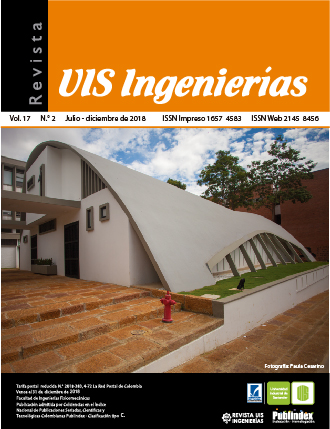Voltage sag state estimation based on l_1-norm minimization methods in radial electric power distribution system
Published 2018-05-17
How to Cite
Copyright (c) 2018 REVISTA UIS INGENIERÍAS

This work is licensed under a Creative Commons Attribution-NoDerivatives 4.0 International License.
Abstract
Voltage sags have a high impact on the proper equipment operation and the electric power end-user processes continuity. Economic losses are a growing problem for the electric utilities, regulators and electric energy final customers and therefore, the formulation of new mathematical methods for voltage sags diagnosis are needed. In this sense, the state estimation methods seek the determination of the frequency or the number of voltage sags that an end-user would experience. In this research area, optimization problems based on techniques such as singular value decomposition, voltage profile curve fitting and voltage sag source location have been formulated. The results of these approaches may be inaccurate when the pre-fault currents, non-zero fault impedances and unbalanced conditions are considered. We will evidence that the results from singular value decomposition method are inaccurate considering these real fault conditions. Also, a new mathematical formulation of the voltage sag state estimation problem based on ℓ1-norm minimization is proposed in this work. The proposed method is applied and validated to the IEEE 33-node test distribution network. Voltage sags caused for network faults are only considered. The results validate a remarkable improvement in comparison with the singular value decomposition method and show an innovative tool for voltage sags state estimation in radial electric power distribution systems
Downloads
References
F. Salim, K. M. Nor, D. M. Said, and A. A. A. Rahman, “Voltage sags cost estimation for Malaysian industries,” in IEEE International Conference on Power and Energy, PECon, 2014, pp. 41–46.
S. Jamali, A. Bahmanyar, and E. Bompard, “Fault location method for distribution networks using smart meters,” Measurement, vol. 102, pp. 150–157, 2017.
N. C. Woolley, M. Avendaño-Mora, A. P. Woolley, R. Preece, and J. V. Milanovic, “Probabilistic estimation of voltage sags using erroneous measurement information,” Electr. Power Syst. Res., vol. 106, pp. 142–150, 2014.
L. E. Perdomo-Orjuela, A. A. Rodríguez, and F. Santamaría, “Metodología para el registro de parámetros de calidad de energía en microrredes Inteligentes,” Rev. UIS Ing., vol. 15, no. 2, pp. 117–123, 2016.
I. B. N. C. Cruz, A. P. Lavega, and J. R. C. Orillaza, “Overview of Methods for Voltage Sag Performance Estimation,” in Harmonics and Quality of Power (ICHQP), 2016 17th International Conference on, 2016, pp. 508–512.
A. Al-Wakeel, J. Wu, M. Verga, and N. Jenkins, “State estimation of low voltage microgrid using an iteratively reweighted least squares method,” CIRED Work., no. 0383, pp. 1–5, 2014.
X. Zambrano, A. Hernandez, M. Izzeddine, and R. M. De Castro, “Estimation of Voltage Sags from a Limited Set of Monitors in Power Systems,” IEEE Trans. Power Deliv., vol. 32, no. 2, pp. 656–665, 2017.
N. C. Woolley, M. Avendaño-Mora, A. P. Woolley, R. Preece, and J. V. Milanovic, “Probabilistic estimation of voltage sags using erroneous measurement information,” Electr. Power Syst. Res., vol. 106, pp. 142–150, 2014.
J. C. Cebrian, N. Kagan, and J. V Milanović, “Probabilistic Estimation of Distribution Network Performance With Respect to Voltage Sags and Interruptions Considering Network Protection Setting : Part I – The Methodology,” IEEE Trans. Power Deliv., vol. PP, no. 99, pp. 1–9, 2017.
A. Hernández, E. Espinosa-juárez, and R. M. De Castro, “SVD Applied to Voltage Sag State Estimation,” IEEE Trans. Power Deliv., vol. 28, no. 2, pp. 866–874, 2013.
S.-J. Kim, K. Koh, M. Lustig, S. Boyd, and D. Gorinevsky, “An Interior-Point Method for Large-Scale L1-Regularized Least Squares,” IEEE J. Sel. Top. Signal Process., vol. 1, no. 4, pp. 606–617, 2007.
M. Majidi, H. Livani, and M. Etezadi-Amoli, “Distribution system state estimation using compressive sensing,” Electr. Power Energy Syst., vol. 88, pp. 175–186, 2017.
M. Majidi, M. Etezadi-Amoli, H. Livani, and M. S. Fadali, “Distribution systems state estimation using sparsified voltage profile,” Electr. Power Syst. Res., vol. 136, pp. 69–78, 2016.
J. E. R. Baptista, A. B. Rodrigues, and M. da G. da Silva, “Two Probabilistic Methods for Voltage Sag Estimation in Distribution Systems,” in 2016 Power Systems Computation Conference (PSCC), 2016, pp. 1–7.
M. Figueiredo, R. Nowak, and S. J. Wright, “Gradient projection for sparse reconstruction: application to compressed sensing and other inverse problems,” IEEE J. Sel. Top. Signal Process., vol. vol, no. 4, pp. 586–597, 2007.
I. CVX Research, “CVX: Matlab software for disciplined convex programming.” 2013.
S. Boyd and L. Vandenberghe, Convex Optimization. Cambridge University Press, 2010.
H. A. Abdelsalam, A. Y. Abdelaziz, and V. Mukherjee, “Optimal PMU placement in a distribution network considering network reconfiguration,” 2014 Int. Conf. Circuits, Power Comput. Technol. ICCPCT 2014, pp. 191–196, 2014.
J. Blanco Solano, J. F. Petit, and G. Ordonez Plata, “Optimal placement of voltage sag monitors in smart distribution systems: Impact of the dynamic network reconfiguration,” in 2015 IEEE PES Innovative Smart Grid Technologies Latin America (ISGT LATAM), 2015, pp. 361–365.
M. Avendaño-Mora and J. V. Milanović, “Monitor placement for reliable estimation of voltage sags in power networks,” IEEE Trans. Power Deliv., vol. 27, no. 2, pp. 936–944, 2012.
E. Cabezas-Jaimes, J. Blanco-Solano, J. Petit, and G. Ordóñez-Plata, “Optimal Placement of Voltage Sag Meters in Distribution Networks using Fault Location Constraints,” Rev.UIS Ing., vol. 16, no. 2, pp. 253–261, 2017.
